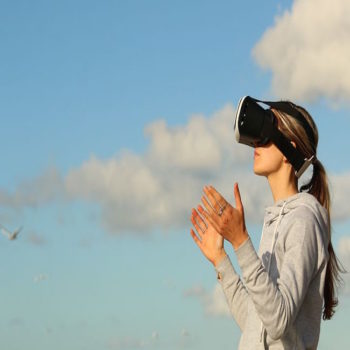There’s No Gimmick in Walmart's and Kantar’s VR Push
by Hugh Williams on 21st Feb 2018 in News

Virtual reality in retail has always been something of a gimmick, but with Walmart acquiring VR company Spatialand and Kantar starting up a new consultancy specifically applying VR to the retail sector, it seems there’s a change in the wind. In this piece, Sophie Light-Wilkinson, VP marketing, BazaarVoice, explains why.
The greatest challenges to the role of VR in the retail sector have always been around practicality. Are we really about to see the likes of Tesco invest in headsets for a select few customers to enjoy a digitised version of the weekly shop?
No, it won’t happen this way. But a gap does exist between the online and offline worlds that we are yet to see fully addressed. Our recent research into the ROBO (research online, buy offline) phenomena found that among more than 30 of the world’s leading retailers, at least 45% of brick-and-mortar buyers are reading online reviews on their mobiles before purchasing products.
The simple truth is what we have traditionally thought of as ‘low consideration’ products are becoming more popular searches than high consideration products. For example, people are more likely to google for a new pair of shoes than a mortgage. As we make our way down the high street we’re increasingly demanding the wider perspective and comparisons we’re afforded by the digital journey.
Several commentators in this field have already ironed out differences in the application of VR in retail and AR, focusing on the applicability of the former to the business end, while augmented reality (for its ubiquity through mobile devices) could make a far more instant appearance in-store. However, when retailers decide to implement new technologies, they need to keep in mind content is the engine that drives conversion.

Sophie Light-Wilkinson, VP Marketing, BazaarVoice
Merging digital perspective and real world instinct
Companies like IKEA and Wayfair have been on board with enabling consumers to answer the question “what’s the best sized sofa for my space?” for years. It could easily be the oldest application of virtual and augmented reality technology in retail.
However, the compelling addition to this is the ratings and reviews we cherish online. New technologies will certainly change the way consumers purchase good offline and online, but they are only as good as the content that retailers generate and deliver to their customers.
Shoppers have always relied on word-of-mouth recommendations to decide what to buy. Every day, people write reviews, and post photos and videos about the products and brands they love — and the ones they don’t. Shoppers turn to this invisible crowd, reading through product reviews to decide what to buy.
Looking beyond ‘R&R’
Ratings and reviews are just part of the picture, as customer generated content matures, consumer word-of-mouth now includes social imagery, questions and answers, and even video.
Surfacing different types of content together can help consumers get a better understanding of your products. Adding elements like visual customer content from social media and a Q&A platform to help answer shoppers’ questions is a good step toward improving the experience for shoppers.
Imagine, for a second, a customer is in a shop and can’t decide between two similar items of clothing — or just can’t tell whether the item is worth the money. Now, imagine they could turn and ask someone with a similar body type and style preference how the item looks on them and see their review. This empowers them to make a reasoned choice on the spot.
Online reviews make this kind of interaction possible at scale. They connect potential customers with real people who provide their unbiased opinion, and their opinions help them make the best decisions possible. They give social proof that they’re making the right decision.
Quality content
One of the buzzier concepts in e-commerce, social proof explains a psychological and social phenomenon where people turn to the crowd to figure out what is the right thing to do. In short, it’s that feeling when, if everyone is doing something, they should probably be doing it too.
The next stage of social proof will see people give back to the community that guided them to make the right decisions. This stage will see content propagate far more quickly based on simple psychology. As Benjamin Franklin famously stated, “he that has once done you a kindness will be more ready to do you another”. People buy into the value of what they’re sharing and it makes them far more inclined to do it again.
With even more content being generated, retailers and brands will then be able to use deep insights into the customer experience to identify problems, faults and feed this into the supply chain to improve product quality and in-store delivery.
This sits at the heart of what Kantar’s VR venture looks to explore. Where Walmart’s acquisition is focused entirely on the consumer-facing element, Kantar’s consultancy looks more broadly at the way retailers inform the store layout. For retail, nothing is more asset intensive than the decision to remodel or redesign.
Creating new ways for the business and consumer to experience a brand is crucial as we see more and more industries being disrupted by technological change. Both Walmart and Kantar recognise the urgency, but what remains to be seen is whether they make the most of the content available – and this is what will decide VR’s success.
Augmented RealityE-CommerceIn-storeVirtual Reality








Follow ExchangeWire